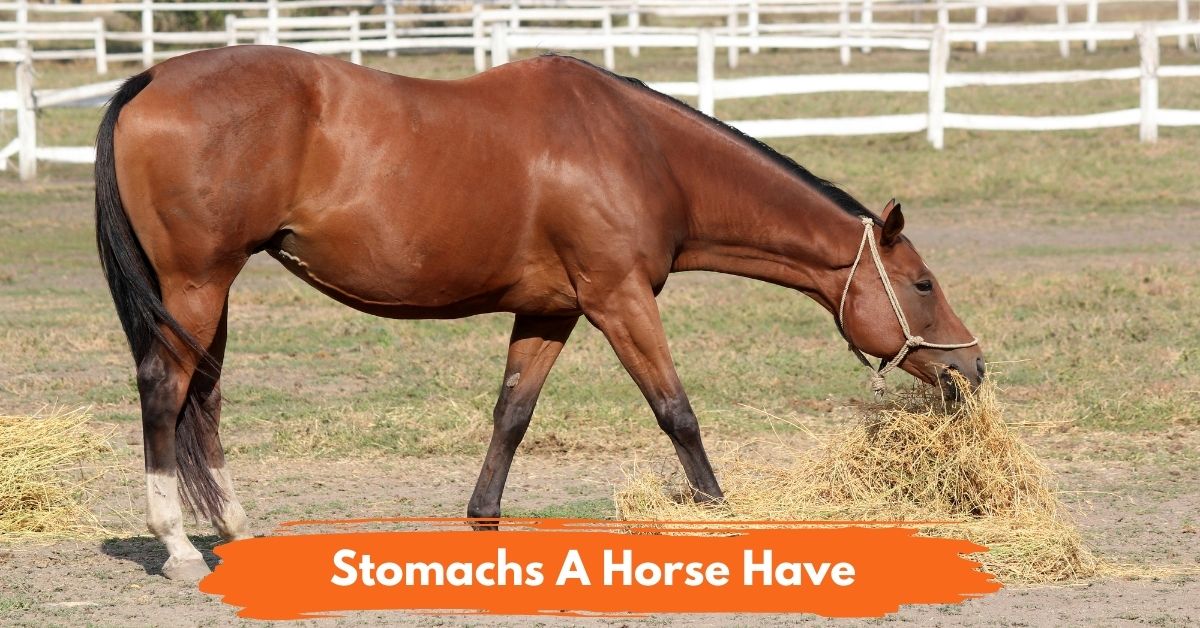
A horse is like a human with only one stomach that works with other digestive parts. They are large and small intestines, hindgut, large colon, tiny colon, and cecum. This system is straightforward, unlike a ruminant stomach with four chambers.
Some may think all herbivores are ruminants, like cows, goats, and sheep. But horses are not included in the list. Horses are herbivores, but they have one stomach, like carnivores and omnivores.
Since horses have only one stomach, it gets help from the colon and cecum. Due to this comparison, you’ll realize that this is why horses have sensitive stomachs. So, you must be careful with the food you give your horses.
In this article, I will go deeper into a horse’s digestive system and explain how they digestive their food.
What Type of Stomach Does the Horse Have?
The type of stomach of the horse is for non-ruminants. It means that it’s one stomach with an uncomplicated structure. You may compare it with a human’s stomach. But it has three main parts: fundic, pyloric regions, and saccus caecus.
How Many Stomachs Does the Horse Have?
Grass and plants contain cellulose that is hard to break. It’s the reason why ruminants like cattle have more than one stomach. The chambers work for better digestion and nutrient absorption.
A horse has one stomach, but it doesn’t mean that the many stomach chambers of a cow are better. Let’s look at the advantages and disadvantages of this feature.
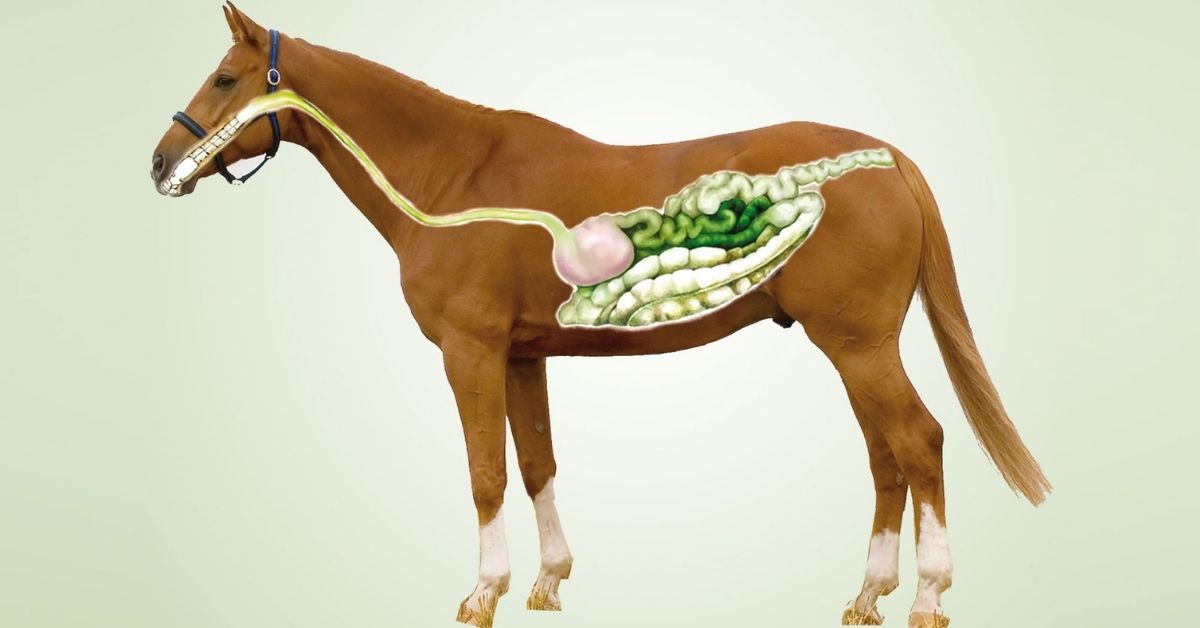
Advantages
For Agility and Athleticism
Having only one heart doesn’t make the abdomen cramped. This feature also results in a slim and light body. It’s the main reason why horses are agile and athletic. They can run fast and escape danger.
Faster Digestion
Since a horse has one stomach, the food doesn’t need to enter several chambers. Digestion only takes place in one place. So, there’s no doubt that horses digest food faster than cattle.
You should know that the horse’s stomach empties even if it’s only 67% full. It’s a consistent process as undigested food leaves the stomach when it’s time. That’s why you have to care about the possibility of starvation.
Maintains the Ideal Weight
Due to fast digestion, it’s easy for horses to maintain the ideal weight. They also burn calories as they’re active animals.
Disadvantages
Digestive Issues
Even though it has only one stomach, issues can arise in no time due to the sensitive bacteria.
The shortcoming of Nutrient Absorption
One stomach and fast digestion have a downside. Because of these things, horses can’t absorb all the nutrients they can get from their feed. They may suffer serious digestive problems if they don’t get enough feed.

How Long Does It Take Your Horse to Digest Food?
The food that horses eat has only 15 minutes to stay in their stomach. But it takes 24 hours for the food to pass through the equine’s digestive system. It’s possible as the entire digestive tract is 100 meters long.
The food proceeds to the small intestine after leaving the stomach. Further nutrient absorption occurs in the small intestine for 30 to 60 minutes.
Then the food travels through the large intestine or hindgut for an hour and a half. The remaining undigested food goes to the cecum, large colon, and small colon.
While ruminants have four digestive compartments, a horse has a cecum to do a similar job. Feed particles can remain in the hindgut for several hours. During this period, the bacteria break and ferment the plant fiber.
As the plant matter ferments, the gut tries to get as many nutrients as possible. The digestion inside the horse’s system can cause a problem on certain occasions.
To avoid issues, horses shouldn’t eat too fast. An improper way of chewing doesn’t help as well. As a horse owner, you must refrain from feeding a heap of feed at a time. Due to the horse’s small stomach, they should eat a small amount but many times.
Those things lead to excessive gas and fermentation. They are the causes of digestive issues. It happens because the food matter lingers in the horse’s gut for more than 24 hours.
What is the Function of the Stomach in a Horse?
Horses and cattle both consume hay, grass, and other plants. When this food gets into their stomach, these animals need to break down cellulose. Cattle, as a ruminant, can digest 50% to 90% of cellulose in their rumen.
Since a horse has only one stomach, it can digest 40% of cellulose. It’s the outcome after the food blends with the substances in the stomach. They are digestive enzymes, hydrochloric acid, and pepsin.
Apart from digesting cellulose, a horse’s stomach can also deal with fats and proteins. It occurs when the fermentation of cellulose ends and the PH level turns 5.4.
The final destination of food in the stomach is the pyloric region. It’s where the PH level goes down to 2.6. At this point, the bacteria for fermentation disappear. It happens when protein digestion is at its peak.
Thus, a horse’s stomach functions to digest cellulose and other nutrients. Forage can provide 7% to 8% crude protein that is also digestible. A horse can digest food quicker than animals with many stomachs despite only one stomach.
Its stomach has parts and enzymes that result in impressive digestion. But this quick process makes the stomach sensitive. That’s why it’s recommended to feed a horse a small amount of food but many times a day.
How Big is a Horse’s Stomach?
Horses are large animals so it will surprise you that they have a small stomach. It only comprises 10% of their digestive system. This part is around 9 to 15 liters.
| Pig | Ruminant | Equine | |
|---|---|---|---|
| Stomach | 29% | 70% | 9–10% |
| Small Intestine | 33% | 19% | 30% |
| Cecum | 6% | 3% | 16% |
| Large Intestine | 32% | 7% | 45% |
Why Does Your Horse’s Stomach Rumble When She Eats?
It’s normal when your horse’s stomach rumbles when she eats. You’ll also hear it when the horse is hungry and exposed to a new feed. It’s called intestinal motility.
I can’t blame you for worrying about this. When it happened among my horses for the first time, I couldn’t help but panic. The rumbles can be too loud, and you can hear them from a few away.
A rumbling stomach happens to healthy horses too. Changes in their diet and upset hindgut can cause it. Still, you have to do further observation. You can assess the health of your horses through the Whole Horse Exam (WHE).
You have to observe the horse’s appearance, attitude, and manure. Other things that you have to pay attention to are the heart rate and gums. You have to distinguish the kind of noise coming from the horse’s stomach.
Intestinal motility can happen when you alter a horse’s diet. But you have to be vigilant if there are any signs of colic. For assurance, you must submit your findings to the veterinarian for discussion.
Horse Digestive System and Their Functions
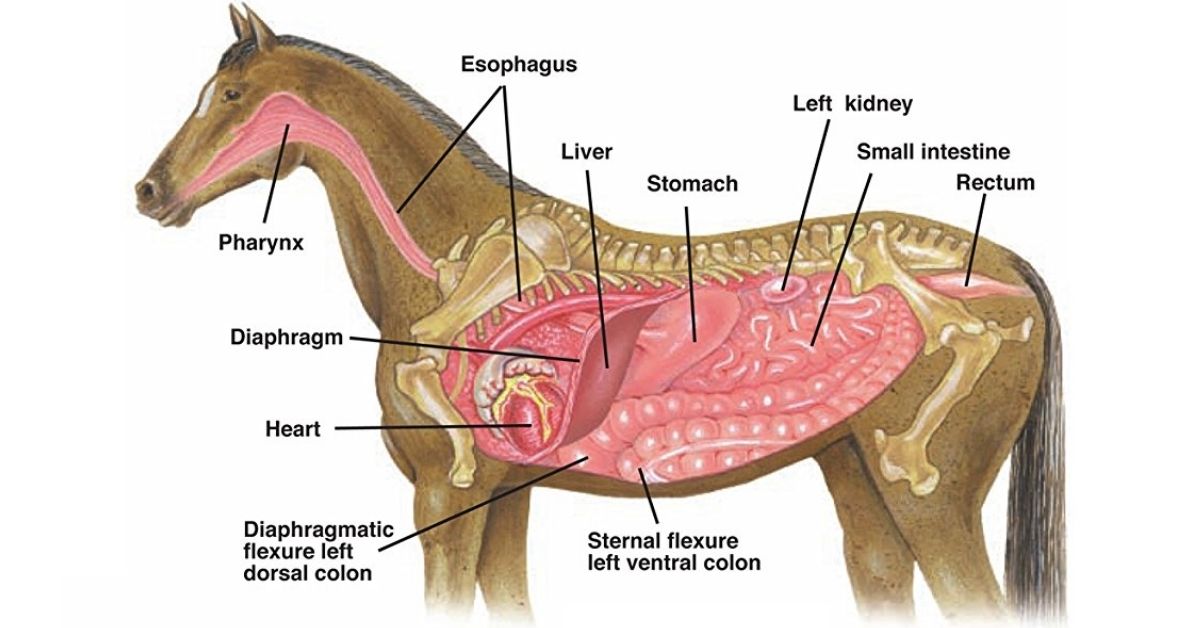
The stomach takes up only 10% of the horse’s digestive system and the large intestine occupies 45%. The next biggest part is the small intestine, and the cecum is 16%. Apart from size, you have to know the functions of these parts.
Mouth
Yes! The mouth is a part of a horse’s digestive system. Digestion always begins by chewing or breaking down food. So, a good set of teeth is crucial for good digestion.
A horse produces 9 to 10 gallons of saliva daily. The saliva lubricates the feed, which becomes boluses. These boluses are round food masses that are easy to swallow.
Saliva is helpful in the stomach as it can regulate PH levels. The breaking down of carbohydrates will likely begin in the stomach. The horse’s saliva has a little amylase, so it doesn’t do much in digesting carbohydrates.
Pharynx and Esophagus
After the horse chews the food, the journey of boluses starts in the pharynx. It’s a short, muscular tube shaped like a funnel. This tube is the passage between the mouth and esophagus.
The muscular action of a horse’s pharynx creates a force that sends food to the esophagus. An adult horse usually has a 4 to 5 feet long esophagus. This part has a covering of a mucus membrane, which provides lubrication.
The boluses get lubricated in the esophagus. But they reach the stomach through rhythmic muscular contractions called peristalsis. This action only goes in one direction, which is why equines can’t puke or throw up.
If reflux occurs, the food and water will likely exit through the nostrils. When a horse chokes, it means an obstructed esophagus. The animal can still breathe, but it’s impossible to eat and drink.
So, it would help if you had a veterinarian around for a choking incident. But ingested food and gas from the stomach won’t return to the esophagus.
A cardiac sphincter or a muscular one-way valve blocks consumed food. This part is also responsible for sending the boluses to the stomach.
Stomach
When boluses are in the stomach, chemical digestion commences. A horse’s stomach has glandular and non-glandular regions.
Glandular Region (Lower Part)
Secretions take place in the glandular region. Hence, this is where hydrochloric acid and peptidases dwell. These substances can digest protein.
Horses in the wild thrive through grazing, so their stomach is always filled with forage. In modern times, horses under human care have two large portions of feed and forage.
So, the stomach of modern horses is sometimes empty. Yet, an empty stomach still gives off hydrochloric acid.
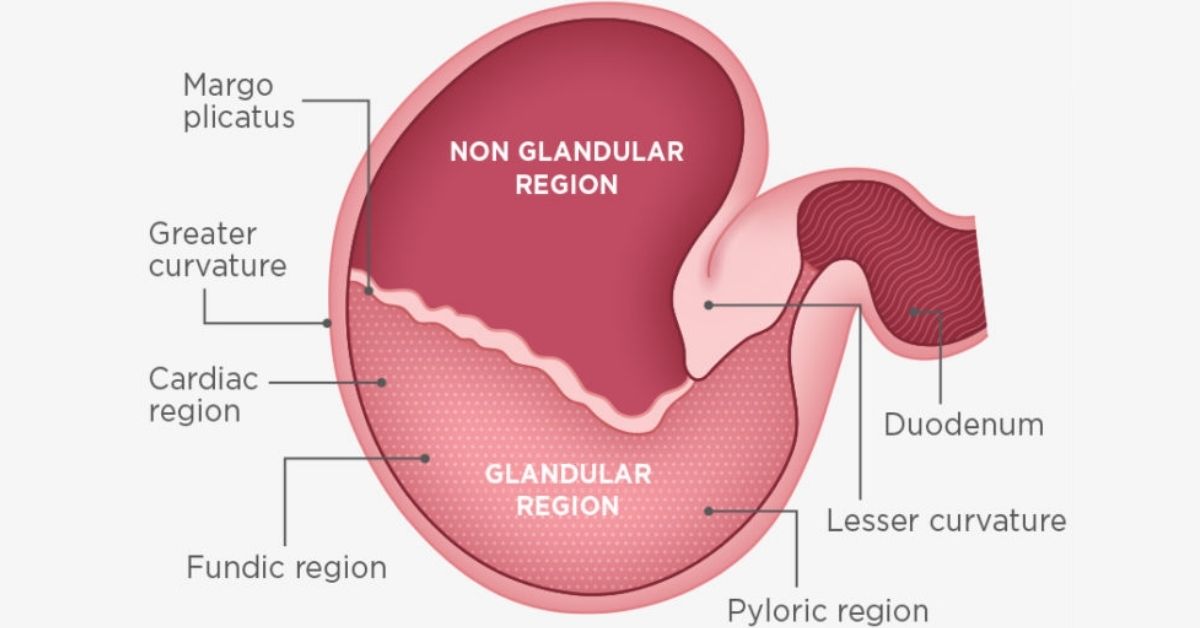
Non-glandular region (Upper Part)
The upper part of the stomach doesn’t have protection against low PH levels. So, a horse is at risk of a gastric ulcer. The low density or recent food intake stays in this region.
The low-density feed and roughage have a higher PH level due to saliva exposure. Insufficient food intake will cause the PH to decline. When it happens, a gastric ulcer can form. I must say that meeting the feeding schedule is vital.
Small Intestine or Foregut
The food goes forward to the small intestine, where digestion continues. It blends with some enzymes that process carbohydrates, fats, and protein. Equines don’t have a gallbladder, so the liver releases bile for fat digestion.
Horses can absorb a high amount of fat even without a gallbladder. Bicarbonate does the job in the small intestine of adjusting the PH level.
The absorption of nutrients in the small intestine depends on various factors. Passage rate, feed processing, bioavailability, and feedstuff composition affect this process.
Large Intestine or Hindgut
The large intestine processes fat, protein, carbohydrates, and other nonstructural nutrients. But most of the foods that horses eat have structural carbohydrates.
So, the undigested food particles also go through fermentation in the large intestine. It happens with the help of microorganisms such as fungi, bacteria, and protozoa.
This process breaks down energy-rich compounds. Its byproducts include fatty acids that convert into energy used by horses. The journey of horse’s food or boluses doesn’t end here. Other parts support the large intestine.
Cecum
The cecum is the rumen in ruminants when it comes to functions. This part can hold 7 to 10 gallons of liquid. Due to the cecum’s size and structure, the passage of boluses becomes slow.
But this is a chance to digest fiber for up to seven hours. Cecum has notable muscular contractions to put the food particles in motion. But this function is not always on the positive side.
Strong contractions can twist and displace the cecum. It’s likely to happen when a horse consumes a heap of dry feed with only a little water. The animal will experience pain from cecum compaction and colic.
The microorganisms in the cecum need time to become accustomed to new food. It requires 2 to 3 weeks. So, you have to introduce a new feed little by little within a week or two.
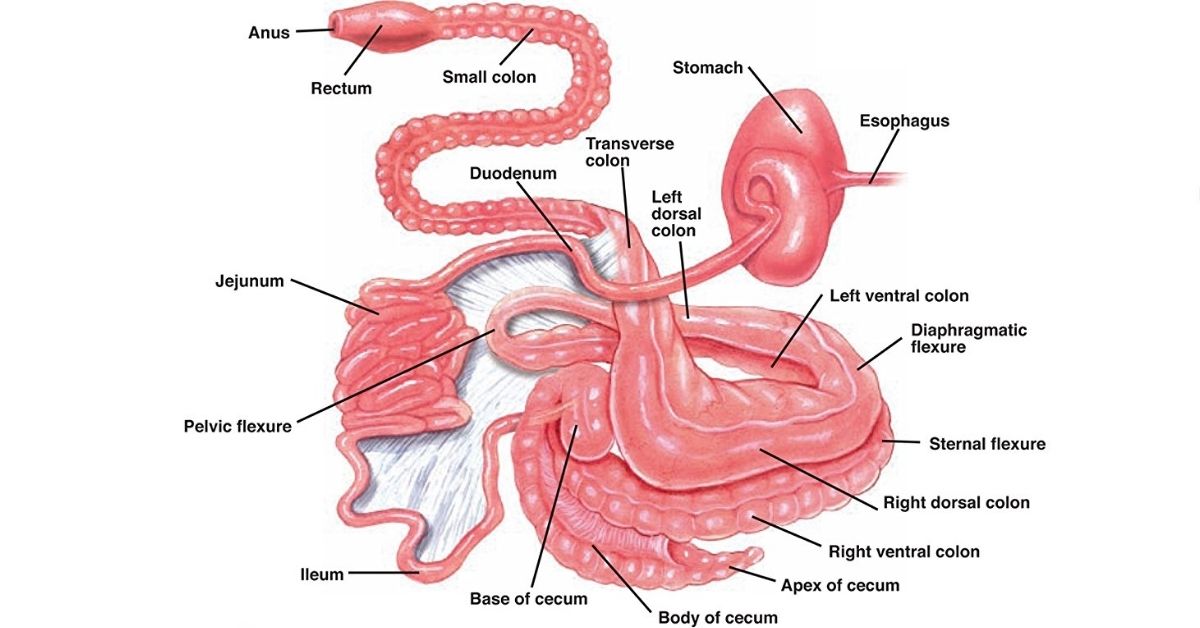
Large Colon
The large colon has a length of 9.8 to 11.5 feet and a capacity of 22.7 gallons. It can have a width of 8 inches but shrink into 3 to 4 inches.
Fermentation continues in the large colon. It works due to the present microbes like amino acids, ammonia, B vitamins, methane, and VFA.
The large colon has a length of 9.8 to 11.5 feet and a capacity of 22.7 gallons. It can have a width of 8 inches but shrinks into 3 to 4 inches.
Instead, it can get electrolytes and minerals like chloride, potassium, and sodium. The absorption happens through the water.
Small Colon and Rectum
Water absorption and fecal formation all happen in the small colon. Fecal balls travel through a 12-inch passage to the rectum. It’s the last part of an equine’s digestive system.
Conclusion
Even though a horse has only one stomach, it serves its purpose well! But it gets help from other digestive parts. This article shows you the functions of all these parts.
Knowing them lets you understand why the horse’s gut is sensitive. It’s also why there’s an ideal way of feeding horses.
These animals should eat a small amount of feed and roughage but many servings. Understanding the equine’s digestive system is a way to keep your horses healthy.
